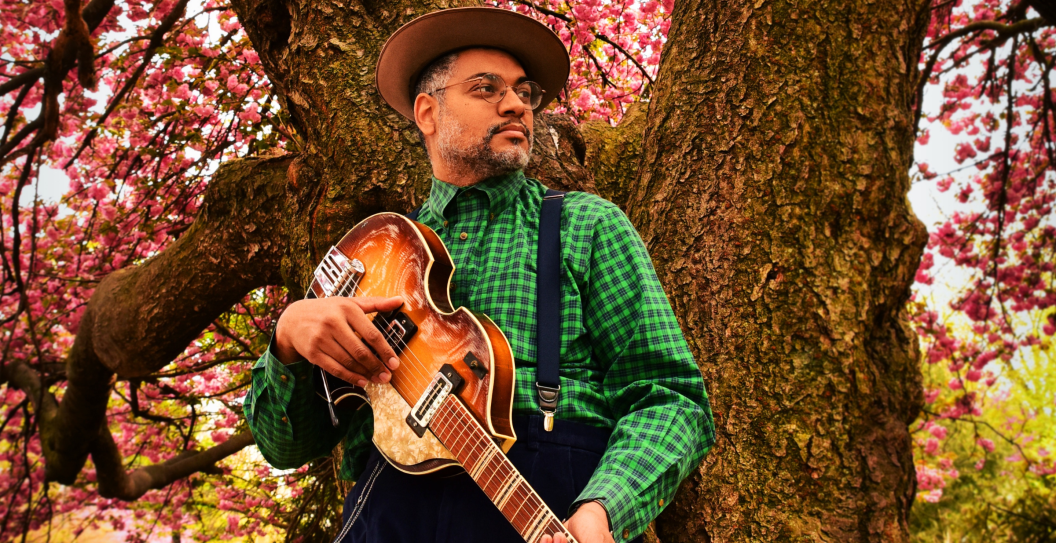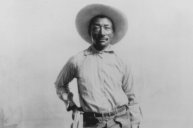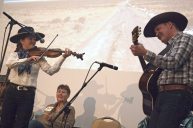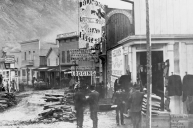The mythology of the heroic cowboy and the lawless Wild West looms large in the American psyche. And even more than a hundred years later, perhaps no other concept is more ingrained in the nation's ideology. But the stereotypical stories of bravado and glory on the western frontier during the development of the American West exclude much of the era's real and complicated history. A new docuseries aims to set the record straight.
"You think of the white cowboy with the white hat on the white horse, you think of the legends," says Grammy Award-winning singer-songwriter Dom Flemons who narrates the series, in its first episode. "The American West was infinitely more complex and diverse than Hollywood led us to believe."
The Real Wild West, a four-part release from Curiosity Stream, retells the history of the American west to incorporate and highlight stories that are often left out of traditional narratives. It digs into the lives of frontier women, Black settlements, Black cowboys and Mexican Vaqueros, the removal and killing of Indigenous tribes and the near-elimination of native bison, and Chinese workers' construction of the Transcontinental Railroad, as well as the ways present day descendants of some of those groups, including Black rodeo riders and Indigenous land activists, carry on their ancestral history.
Narrating the series is a natural extension of Flemons' work in many ways. His stage moniker, The American Songster, nods at both his accomplished status as a multi-instrumentalist and the deep historical knowledge and research that informs his work; his Grammy-nominated 2018 album Black Cowboys, explores some of the untold history of Black cowboys in the American West (an estimated one-fourth of all cowboys were Black and many more not white); and much of his music features traditional folk instruments like the harmonica and bones.
In the series' opening scenes, Flemons sets its stakes, neatly summing up the tension between history and mythology: "There are two types of west. There's the west of the imagination. And then there's the real west, the literal west, which is still here. When you begin to recognize the mythology of the west, then you can start seeing the real people who are standing out there on the range and out in the fields."
By situating typical beats of history next to the stories we don't often hear, The Real Wild West holds space for thought-provoking complexities. For more than 10,000 years, an estimated 300 tribes made up of 25-100 million Indigenous people lived across the land that eventually comprised the United States. With that understanding, the series kicks off with Lewis and Clark's expedition to explore and map the territory the Louisiana Purchase added to the United States in 1803. The series highlights how during that expedition, Sacagawea, a Lemhi Shoshone woman, who was likely a teenager at the time, guided Louis and Clark and brokered treaties for them with tribes whose land they passed through along the way.
Marking the expedition as the door that opened the west up, The Real Wild West chronicles the real lives of some of the west's most famous characters, the devastation the beaver trade and bison slaughter brought to the western landscapes, the Civil War, The Homestead Act, the Trail of Tears, the driving greed of a Manifest Destiny directive, the Oregon Trail (which was at one point so crowded it compared to Broadway street in New York City), the wars fought to take control of Texas and California, and the formation of the myth of the American west in Hollywood's western movies. At each stage, series creators layer in interviews with historians and ancestors who speak to the mistreatment and sometimes murder of immigrants, Black people, Indigenous tribes, and others, all in the name of 'conquering' the Wild West.
Reckoning with the real history of the west can be painful and frustrating. "It's impossible to take away what's been done," Flemons says. But acceptance and understanding go a long way: "At the same time there's another part to me that says that now that we're in the future, these are the times where we can reclaim the stories that have been forgotten or lost."
Flemons also lent the title track off his newest album, Traveling Wildfire, to the series as its theme song. Fittingly, it unfolds along a slow, relentless guitar melody punctuated by whiny pedal steel. Flemons wrote the lyrics while trapped on the road by Hurricane Ida, thinking about the storm's powerful downpour juxtaposed with the intense wildfires burning in the west at the time. In it, he strings together eerie image after image: "There's a dark moon in the valley / Covered in clouds made of clay / And the wind's rolling scolding voice / Will make the Mississippi change its way."
"There's a comfort in knowing that you're moving forward in time, but there's also a tension that's set into place when you know things are not quite right. And 'Traveling Wildfire' was built on those emotions and feelings," Flemons says.
That tension is impossible to overlook in the series too, as well as the history of the American west. About it, Flemons suggests asking: what can we learn from this history? What other stories should we know beyond Hollywood's glorified imagery? And how do we continue to amplify the real story?
"I'd hope that people would take away that there's so much more to know," he says. "That's one of the things that we can all do for the ancestors, is really tell their stories and let their stories be heard so that then we can make our own opinions about them."
READ MORE: '1883' LaMonica Garrett Brings to Life the True Legacy of Black Cowboys [Interview]




